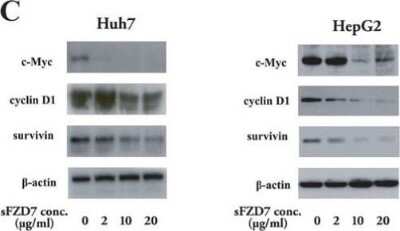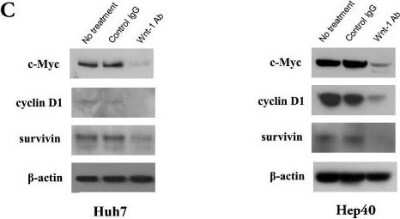Survivin Antibody [HRP]
Novus Biologicals, part of Bio-Techne | Catalog # NB500-201H


Conjugate
Catalog #
Forumulation
Catalog #
Key Product Details
Species Reactivity
Validated:
Human, Mouse, Rat, Canine, Feline, Guinea Pig, Hamster
Cited:
Human
Applications
Validated:
Chromatin Immunoprecipitation (ChIP), Dual RNAscope ISH-IHC, ELISA, Flow Cytometry, Immunocytochemistry/ Immunofluorescence, Immunohistochemistry, Immunohistochemistry-Frozen, Immunohistochemistry-Paraffin, Immunoprecipitation, Knockdown Validated, Western Blot
Cited:
Western Blot
Label
HRP
Antibody Source
Polyclonal Rabbit IgG
Concentration
Please see the vial label for concentration. If unlisted please contact technical services.
Product Specifications
Immunogen
This Survivin Antibody was developed against full length recombinant human Survivin [UniProt# O15392]
Reactivity Notes
Hamster reactivity reported in scientific literature (PMID: 23405201). Guinea Pig reactivity reported in scientific literature (PMID: 21364656).
Localization
Nuclear
Clonality
Polyclonal
Host
Rabbit
Isotype
IgG
Theoretical MW
16 kDa.
Disclaimer note: The observed molecular weight of the protein may vary from the listed predicted molecular weight due to post translational modifications, post translation cleavages, relative charges, and other experimental factors.
Disclaimer note: The observed molecular weight of the protein may vary from the listed predicted molecular weight due to post translational modifications, post translation cleavages, relative charges, and other experimental factors.
Scientific Data Images for Survivin Antibody [HRP]
Western Blot: Survivin Antibody [HRP] [NB500-201H] - sFZD7 inhibits Wnt/beta-catenin signaling and suppresses the expression of downstream oncoproteins. The effect of sFZD7 on the expression of beta-catenin/Tcf4 target genes c-Myc, cyclin D1, and survivin. Huh7 and HepG2 cells were incubated for 48 h with sFZD7 at various concentrations and c-Myc, cyclin D1, survivin, and beta-actin (loading control) levels were determined by Western blotting using specific antibodies. Image collected and cropped by CiteAb from the following publication (https://molecular-cancer.biomedcentral.com/articles/10.1186/1476-4598-10-16), licensed under a CC-BY license.
Western Blot: Survivin Antibody [HRP] [NB500-201H] - Anti-Wnt-1 antibody inhibited beta-catenin/Tcf4 transcriptional activity. The effect of anti-Wnt-1 antibody on the expression of beta-catenin/Tcf4 target genes c-Myc, cyclin D1, and survivin. Huh7 and Hep40 cells were incubated for 48 hr with anti-Wnt-1 antibody (2 ug/ml) and c-Myc, cyclin D1, survivin and beta-actin (loading control) levels were determined by Western blotting using specific antibodies. Image collected and cropped by CiteAb from the following publication (https://molecular-cancer.biomedcentral.com/articles/10.1186/1476-4598-8-76), licensed under a CC-BY license.
Western Blot: Survivin Antibody [HRP] [NB500-201H] -
Western Blot: Survivin Antibody [HRP] [NB500-201H] - sFZD7 inhibits Wnt/ beta-catenin signaling & suppresses the expression of downstream oncoproteins. (A). sFZD7 decreased nuclear beta-catenin accumulation but did not decrease cytoplasmic beta-catenin in Huh7 & HepG2 cells. Histone-H3 & beta-actin were used as loading controls for nuclear & cytoplasmic proteins, respectively. (B). Tcf4 reporter assay of Tcf4-dependent transcriptional activity in Huh7 & HepG2 cells. Cells were co-transfected with plasmid encoding beta-gal (a control for transfection efficiency) & either the pTOPFLASH or pFOPFLASH reporters. Cells were incubated with control PBS or sFZD7 at various concentrations & harvested after 48 h to measure luciferase & beta-gal activities. Reporter gene activation is expressed as relative light units (RLU) detected in pTOPFLASH or pFOPFLASH transfected cells & normalized for beta-galactosidase activity. The results are expressed as mean ± SD (error bars). Experiments were performed in triplicates (Independent t-test, *P < 0.05.) (C). The effect of sFZD7 on the expression of beta-catenin/Tcf4 target genes c-Myc, cyclin D1, & survivin. Huh7 & HepG2 cells were incubated for 48 h with sFZD7 at various concentrations & c-Myc, cyclin D1, survivin, & beta-actin (loading control) levels were determined by Western blotting using specific antibodies. Image collected & cropped by CiteAb from the following publication (https://molecular-cancer.biomedcentral.com/articles/10.1186/1476-4598-10-16), licensed under a CC-BY license. Not internally tested by Novus Biologicals.Applications for Survivin Antibody [HRP]
Application
Recommended Usage
Chromatin Immunoprecipitation (ChIP)
Optimal dilutions of this antibody should be experimentally determined.
Dual RNAscope ISH-IHC
Optimal dilutions of this antibody should be experimentally determined.
ELISA
Optimal dilutions of this antibody should be experimentally determined.
Flow Cytometry
Optimal dilutions of this antibody should be experimentally determined.
Immunocytochemistry/ Immunofluorescence
Optimal dilutions of this antibody should be experimentally determined.
Immunohistochemistry
Optimal dilutions of this antibody should be experimentally determined.
Immunohistochemistry-Frozen
Optimal dilutions of this antibody should be experimentally determined.
Immunohistochemistry-Paraffin
Optimal dilutions of this antibody should be experimentally determined.
Immunoprecipitation
Optimal dilutions of this antibody should be experimentally determined.
Knockdown Validated
Optimal dilutions of this antibody should be experimentally determined.
Western Blot
Optimal dilutions of this antibody should be experimentally determined.
Application Notes
This Survivin antibody is useful for Chromatin Immunoprecipitation, Immunocytochemistry/Immunofluorescence, Immunohistochemistry on paraffin-embedded sections, Immunoprecipitation and Western Blot. In WB, a band at ~16.5 kDa can be seen. For IHC, prior antigen retrieval (pressure cooking) is recommended for cytoplasmic and nuclear detection of Survivin. Immunohistochemistry-Frozen and Flow Cytometry were reported in scientific literature. The observed molecular weight of the protein may vary from the listed predicted molecular weight due to post translational modifications, post translation cleavages, relative charges, and other experimental factors.
Reviewed Applications
Read 1 review rated 5 using NB500-201H in the following applications:
Formulation, Preparation, and Storage
Purification
Immunogen affinity purified
Formulation
PBS
Preservative
No Preservative
Concentration
Please see the vial label for concentration. If unlisted please contact technical services.
Shipping
The product is shipped with polar packs. Upon receipt, store it immediately at the temperature recommended below.
Stability & Storage
Store at 4C in the dark.
Background: Survivin
Besides being highly abundant in fetal development and expressed in proliferating adult cells such as activated T lymphocytes, erythroblasts, and self-renewing stem cells, survivin is generally absent in adult tissues. However, it is elevated in common cancers such as lung, colon, pancreas, breast and prostate where it drives proliferation, metastasis, poor prognosis, and decreased patient survival (2).
Survivin has been shown to be involved in multiple cellular processes including cell cycle progression, mitotic spindle assembly, kinetochore attachment, angiogenesis, migration, and its anti-apoptotic activity has been linked to both its monomeric and homodimeric forms. Survivin impacts the function of other IAP members, c-IAP1 and c-IAP-2, or modulates the inhibitory activity of XIAP against caspases by forming a stable complex with XIAP and HBXIP. During the intrinsic apoptotic pathway, survivin may prevent the release of mitochondrial APAF1 into the cytoplasm or hinder the association of SMAC with other IAPS, which results in prolonged cell survival (3).
/>References
/> 1. Sah NK, Seniya C. (2015) Survivin splice variants and their diagnostic significance. Tumour Biol. 36(9):6623-31. PMID: 26245993
2. Lladser A, Sanhueza C, Kiessling R, Quest AF. (2011) Is survivin the potential Achilles' heel of cancer? Adv Cancer Res. 111:1-37. PMID: 21704829
3. Wheatley SP, Altieri DC. (2019) Survivin at a glance. J Cell Sci. 132(7). PMID: 30948431
Alternate Names
API4, BIRC5
Gene Symbol
BIRC5
Additional Survivin Products
Product Documents for Survivin Antibody [HRP]
Product Specific Notices for Survivin Antibody [HRP]
This product is for research use only and is not approved for use in humans or in clinical diagnosis. Primary Antibodies are guaranteed for 1 year from date of receipt.
Loading...
Loading...
Loading...
Loading...
Loading...
Loading...

![Western Blot: Survivin Antibody [HRP] [NB500-201H] - Survivin Antibody [HRP]](https://resources.bio-techne.com/images/products/nb500-201h_rabbit-polyclonal-survivin-antibody-hrp-310202416175232.jpg)
![Western Blot: Survivin Antibody [HRP] [NB500-201H] - Survivin Antibody [HRP]](https://resources.bio-techne.com/images/products/nb500-201h_rabbit-polyclonal-survivin-antibody-hrp-31020241618920.jpg)